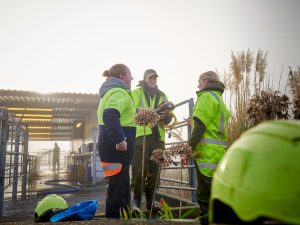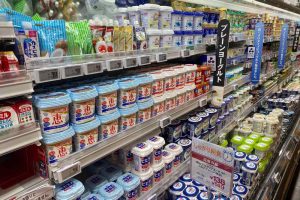
Change is on the way that could affect how we farm.
Big changes, possibly revolutionary, are afoot in the world of food production.
Dairy ingredients, such as high-priced lactoferrin typically extracted from cows’ milk, are now being produced by microbes in vats known as bioreactors.
There’s not a drop of milk in sight and certainly no cows involved. No need for farms or farmers.

Other specialist dairy ingredients are being produced in the same way – it’s happening now in the United States and Singapore with New Zealand startup company Daisy Lab also on the path to creating dairy proteins this way.
Perhaps the most unnerving/ exciting/scary/fascinating thing (depending on how you look at it) is the production of human milk components using human mammary cells, also in bioreactors.
The aim is to create infant formula that’s more “bio-identical” to human milk in terms of proteins and sugars or glycoproteins.
US company Biomilq is using mammary cells while other companies such as US-based Helaina is using genetically modified yeasts that are fermented in bioreactors so they produce human milk proteins and sugars.
TurtleTree is producing cell-based lactoferrin using precision fermentation.
We’ve put up some links so you can take a look at what these companies are up to for yourself.
Their activities and those of companies like them have certainly been on the radar of foresight practitioner Melissa Clark-Reynolds and she shared snippets of their progress at this year’s DairyNZ Farmers’ Forum.
The information, she says, isn’t aimed at scaring people but rather at making them aware.
As a foresight practitioner, or futurist, she uses maths, patterns and data to spot signals that can be gaining traction and could become a trend.
They’re not hunches but things already out in the world such as animal proteins produced by yeasts or cells from an animal, vertical vegetable farming, alternative fuels, new supply chain technologies and of course artificial intelligence.
Some may never develop into a trend or become game-changers.
They may be surpassed quickly by other technologies or lose favour but the job of a foresight practitioner or futurist is to spot the ones that have a high probability of making it and bringing them to the attention of those who may be affected.
Melissa is quick to point out she’s no fortune teller nor is she going to tell anyone what they should do in response to likely trends.
What she’s doing is acting as an educated lookout, making businesses and individuals, in particular food and fibre sector participants, aware of what developments they should sit up and take notice of.
Five years ago, she was dubious about plant-based “meat’s” ability to disrupt the meat protein sector.
It was too far away from the product it was trying to emulate.
“But now we’re seeing massive growth in investment into precision fermentation and I think that there are parts of the primary sector that will be disrupted by this in ways we couldn’t have imagined five years ago.”
Precision fermentation and cell-based technologies use microbes, mainly yeasts, to produce components of animal products such as proteins.
The yeasts or microbes are altered so they contain genetic codes taken from the animal protein or other component.
Those yeasts are fermented, fed on a carbohydrate source, and as a result produce the protein or other component.
“Where they’re starting to get traction is in areas I didn’t expect – cheese-making for instance.
“So, imagine this – instead of taking the carbohydrate and feeding it to a cow to produce milk you put the carbohydrate in a vat and feed it to microbes so they produce milk.
“But you can also alter the microbes so they just produce casein or whey.
“There’s a lot less wastage.
“The areas where we are most likely to see disruption is in the ingredients market, not whole milk.”
That’s an issue for the NZ dairy sector because dairy ingredients extracted from whole milk is a significant part of its business.
“What I’m watching at the moment are these edges – like casein and whey and what it might do to the milk price if it means cheese can be made without milk but it’s bio-identical to milk.”
The price of making dairy components in a vat is getting closer to the price of producing it from milk from cows farmed outdoors, she says.
Milk fats too are being produced in this way. Foods made from ingredients produced through precision fermentation can already be produced and sold to consumers in Singapore.
The technology is being backed there as a way for the country to produce more of the food it needs within its borders even though it has very little land.
Singapore’s “green vision” aims to improve its food security but there’s little room for farming conventionally on the tiny but populous island.
NZ dairy companies are well aware of the technological advances, Melissa says.
She meets with some of the big players but, she says, farmers also need to be aware so they can start thinking about how they might respond to a changing dairy ingredient landscape.
They’re better able to engage with their co-op or processor if they have more insight into where markets could be heading.
“I’m motivated by how do we get a better return to the farmer and how do we do better as a country?” Melissa says.
Where can NZ milk and dairy ingredients compete best?
“What are its attributes that make it stand out from others?
“Be curious and think about what your real advantages are and how to double down on those advantages in a world where there are a lot of changes coming in the next 10 years.”
Those changes won’t arrive in the next two years so there’s time to “get ahead of the curve” by being curious rather than dismissing these developments as a fad.
Curiosity is what will “help to save us”, she says.
If you look back 10 years ago there are probably things you thought would be quite different to what they are now and some things you didn’t really see coming.
Over a 10-year period, changes can feel quite slow but then they seem to come about quickly.
“If we look back, we can see the roots of these changes so we have to prepare.
“If we delay, the changes happen to us and they are outside of our control.”
It’s preferable to be an active participant in the change, she says.
“This is the backbone of our economy – it has to win.
“You can produce milk at scale in New Zealand and you should be thinking about what artisan at scale might mean.”
The naturalness of the product and the environment it comes from are major attributes.
Consumers like to eat with a story behind their food and the story of cows and grass and nature will have advantages for many consumers over the story of carbohydrates, microbes and chemistry.
“We don’t know where this is going to go.
“The more you can stay curious and the more you can wonder about what this might mean, the more likely we are to find solutions to it.
“The more we poo-poo it or mock it or ignore it, the more it’s going to come and bite us on the arse – and I can’t think of a nicer way to put it.”
On her annual research trips
to the US Melissa says the highest-price wholefoods dairy products are those with multiple attributes.
It’s not enough to market a product on one point of difference alone.
For instance one of the highest-priced milks she could find this year was Alexandre Farms chocolate milk at about NZ$10.50/700ml.
It’s marketed as A2/A2, organic, regenerative, grass-based milk.
Another niche player markets itself as Ahimsa, slaughter-free milk and runs a farm system where no cow is killed, calves stay with their mothers and cows are primarily milked by hand.
It’s small scale, but attracts a high price.
While that’s unlikely to be the way to go for NZ’s total milk pool, there are warnings for farmers here about perceived animal welfare.
That’s where working with the beef sector in managing bobby calves will become vitally important, she says.
Other signals
China and India
Population growth has peaked in China with the total forecast to fall from 1.4 billion to close to 1.3b by 2050.
Middle-class population growth rates have slowed.
China’s economic growth has dropped markedly from the double-digit years and more attention has gone to the domestic economy.
Melissa says China has become more focused on providing for itself and New Zealand can expect to see declining demand in some categories over the next 10 years.
India’s population on the other hand is still rising and is believed to have surpassed China’s.
Some predictions suggest a peak of close to 1.7b by 2050.
It is the largest producer and consumer of milk in the world.
Climate change and emissions
“We are coming into a period of turbulence in farming – not only will there be pressure to reduce emissions but there will also be challenges to the way we farm.”
Solar power is making big progress and may outpace biofuels. It’s likely to push the price of biofuels down.
Genetic modification
It is time to look at that again.
Most people accept gene editing as speeding up natural breeding but more education is needed.
For the curious
Want to know more about precision fermentation dairy production?























